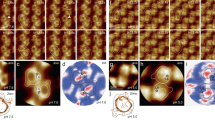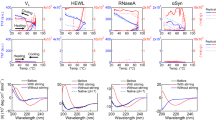Abstract
The E-form of apomyoglobin has been characterized using infrared and fluorescence spectroscopies, revealing a compact core with native like contacts, most probably consisting of 15–20 residues of the A, G and H helices of apomyoglobin. Fast temperature-jump, time-resolved infrared measurements reveal that the core is formed within 96 μs at 46 °C, close to the diffusion limit for loop formation. Remarkably, the folding pathway of the E-form is such that the formation of a limited number of native-like contacts is not rate limiting, or that the contacts form on the same time scale expected for diffusion controlled loop formation.
This is a preview of subscription content, access via your institution
Access options
Subscribe to this journal
Receive 12 print issues and online access
$259.00 per year
only $21.58 per issue
Buy this article
- Purchase on SpringerLink
- Instant access to full article PDF
Prices may be subject to local taxes which are calculated during checkout
Similar content being viewed by others
References
Fink, A.L., Calciano, L.J., Goto, Y. & Palleros, D., In Conformations and forces in protein folding (eds Nail, B.T. & Dill, K.A.) 169–174 (AAAS, Washington, DC; 1991).
Barrick, D. & Baldwin, R.L. Protein Sci. 2, 869–876 (1993).
Privalov, P.L. J. Mol. Biol. 258, 707–25 (1996).
Jennings, P.A. & Wright, P.E. Science 262, 892–896 (1993).
Eliezer, D. et al. Science 270, 487–488 (1995).
Kay, M.S. & Baldwin, R.L. Nature Struct. Biol. 3, 439–445 (1996).
Gilmanshin, R., Dyer, R.B. & Callender, R.H. Protein Sci. 6, 2134–2142 (1997).
Gilmanshin, R., Williams, S., Callender, R.H., Woodruff, W.H. & Dyer, R.B. Proc. Natl. Acad. Sci. USA 94, 3709–3713 (1997).
Scholtz, J.M. & Baldwin, R.L. Annu. Rev. Biophys. Biomol. Struct. 21, 95–118 (1992).
Gilmanshin, R., Williams, S., Callender, R.H., Dyer, R.B. & Woodruff, W.H. Biochemistry 36, 15006–15012 (1997).
Nishii, I., Kataoka, M. & Goto, Y. J. Mol. Biol. 250, 223–238 (1995).
Williams, S. et al. Biochemistry 35, 691–697 (1996).
Schmid, F.X., In Protein folding (ed. Creighton, T.E.) 197–241 (W. H. Freeman and Company, New York; 1992).
Hagen, S.J., Hofrichter, J., Szabo, A. & Eaton, W.A. Proc. Natl. Acad. Sci. USA 93, 11615–11617 (1996).
Chan, C.K. et al. Proc. Natl. Acad. Sci. USA 94, 1779–1784 (1997).
Jacob, M., Schindler, T., Balbach, J. & Schmid, F.X. Proc. Natl. Acad. Sci. USA 94, 5622–5627 (1997).
Ballew, R.M., Sabelko, J., Gruebele, M. Nature Struct. Biol. 3, 923–926 (1996).
Causgrove, T.P. & Dyer, R.B. Biochemistry 32, 11985–11991 (1993).
Author information
Authors and Affiliations
Rights and permissions
About this article
Cite this article
Gilmanshin, R., Callender, R. & Dyer, R. The core of apomyoglobin E-form folds at the diffusion limit. Nat Struct Mol Biol 5, 363–365 (1998). https://doi.org/10.1038/nsb0598-363
Received:
Accepted:
Issue date:
DOI: https://doi.org/10.1038/nsb0598-363
This article is cited by
-
Changes in side chain packing during apomyoglobin folding characterized by pulsed thiol-disulfide exchange
Nature Structural & Molecular Biology (1998)



